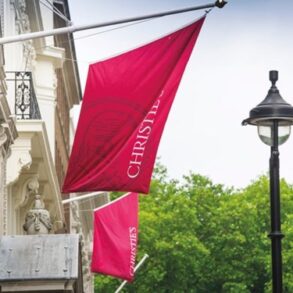To receive Morning Links in your inbox every weekday, sign up for our Breakfast with ARTnews newsletter.
The Headlines
NOTRE-DAME STAINED-GLASS CONTROVERSY GOES TO COURT. A French heritage organization is taking legal action against the President Emmanuel Macron-backed project to replace 19th-century stained-glass windows in Paris’ freshly renovated Notre-Dame Cathedral, with contemporary ones by artist Claire Tabouret, reports Le Parisien. The Sites & Monuments group is joined by at least one private donor to the cathedral’s five-year restoration following damage from a fire, art historian Jean-David Jumeau-Lafond, reports La Tribune de l’Art. On January 27, Sites & Monuments filed an initial appeal in a Paris court, formally attempting to block the removal of the existing stained-glass windows by Eugène Viollet-le-Duc, which were undamaged by the 2019 fire, and are classified as historic monuments. In their formal appeal, the group argues that the public administration has no legal “competence” to do anything beyond “conserving and restoring” the cathedral. A petition against the window replacement was also launched in 2023, with over 278,000 signatures to date. La Tribune de l’Art, which has been vocal against the window replacement, also noted it is “totally illegal,” for the public administration charged with coordinating Notre-Dame’s restoration to have also organized a competition determining which artist would make the contemporary stained-glass windows, as it is “contrary to [their] mission, which is to restore and conserve.” Additionally, the publication asserts that any time spent on the new stained-glass commission, estimated to cost 4 million euros ($4.2 million) is paid for by public coffers, and “topped up by donations from fundraising” intended for the cathedral’s fire repairs.
RETNA VS. HERITAGE AUCTION. Graffiti artist Marquis Lewis, aka RETNA, claims Heritage Auction house is selling his stolen artworks and other allegedly swiped personal items it claims he made, reports Vulture. The online auction clarifies that the items were obtained in “an abandoned property sale.” Yet the artist has filed a lawsuit asserting that none of the items for sale were abandoned, but were instead stolen, when his former landlord seized his studio’s contents worth millions, following a dispute over rent and the artist’s eviction. The lawsuit states the seizure itself was illegal, and names landlords Marianne Miller-Ceporius and Irene Ceporius. RETNA told reporter Rachel Corbett that he was shocked to find personal items from his studio being marketed by Heritage as his artwork, when some, like a painting by his former girlfriend depicting the words “I LOVE U” in pink and blue, or a scrap of canvas he used as a painting tool, were nothing of the kind. “They have my computers, they have my notes, they have my safe,” he said. Lawyers for the auction house have denied the allegations, and the company has proceeded with the sale. The “I LOVE U” painting was sold for $5,500. “Who would look at that,” RETNA asked, “and think I would write ‘I love you’ on a canvas with glitter?”
The Digest
A Paris court has secured 135 stolen Russian avant-garde paintings worth an estimated 200 million euros ($208 million) for the private collector Uthman Khatib. Khatib alleges 1,800 artworks were taken by Mozes Frisch from a storage facility in Germany in 2019, including works by Kazimir Malevich and Wassily Kandinsky. [Artnet News]
President Donald Trump is reviving a first-term plan to create a “National Garden of American Heroes” to coincide with America’s 250th birthday. [The Art Newspaper]
The Swiss Grand Award for Art/Prix Meret Oppenheim has been awarded to Felix Lehner, Pamela Rosengranz, and Miroslave Šik. [Art Dependence]
Artist, curator, and co-founder of Paper magazine, and “legendary downtown bon vivant,” Kim Hastreiter, is colorfully portrayed at one such legendary dinner party by writer Ariel Levy, on the occasion of her forthcoming book, “Stuff: A New York Life of Cultural Chaos.” [The New Yorker]
The Kicker
ODE TO LIBERATED VIDEO ART. In his latest, short essay for The Washington Post, critic Sebastian Smee makes a strong case for video art as nothing short of “the best artworks of our time.” But first, he takes a few hard swings at it. “I can’t begin to tell you how many times I’ve attended rambling biennials and thematic shows stuffed full of tedious, half-baked video art with droning industrial-hum soundtracks, poor production values and almost nonexistent editing,” he writes. Smee effectively describes much of the genre as “a dull and pretentious medium, mired in conceptual longueurs.” What does he mean? “Conceptual art was supposed to be all about ideas. But since the main idea was a Marxist critique of commodification, what this usually translated to was an aggressive hostility to anything that might be seen as visually seductive,” Smee explains. “Video art hasn’t exactly shaken off its early entanglements with conceptualism, minimalism and performance. Rather, it has built on those avant-garde foundations and transcended their limitations,” notes Smee, who lists two of the top five artworks of the 21st century as Christian Marclay’s The Clock and Ragnar Kjartansson’s The Visitors. Both video art. Gradually, “artists intrigued by moving images have pushed beyond these avant-garde preoccupations and constraints and embraced everything the moving-image medium has to offer.” Along with his two favorites, Smee names video artists breaking boundaries today, from Matthew Barney, and Francis Alÿs, to Anri Sala, Angelica Mesiti, and Charles Atlas.
This post was originally published on this site be sure to check out more of their content






